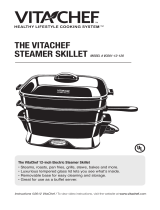
6
Beef, pork, lamb, veal and poultry can be roasted in the skillet. To obtain more
satisfactory results, a metal wire rack can be used to lift the food off of the cooking
surface. A rack is not included with this skillet. However, a metal wire rack that fits into
the bottom of the skillet and is about ½-inch high with smooth support legs can be used.
Follow these basic guidelines for roasting:
1. To help seal in natural juices, roasts should be browned in the skillet before
roasting. Simply preheat the skillet, uncovered, at 325°F/162°C and add the roast.
Brown as desired on all sides. After the roast is browned, lay it in the skillet with the
fat side up. Season as desired.
2. Insert a meat thermometer into the thickest part of roast, making sure that it does
not touch a bone or rest in fat. Cover the skillet and roast at 250°F/120°C. If the
spattering of juices becomes excessive during the roasting period, reduce the
temperature setting to “SIMMER.” A small amount, no more than ½ cup, of water
may be added, if desired.
3. Roast meat to the recommended internal temperature, see the Roasting Guide.
Turn the temperature control to “OFF.” Avoid removing the cover too frequently
while roasting, as this will lengthen the cooking time. Remove the roast from the
skillet and let to stand for 10 minutes. Always use hot pads to remove the lid and
roast. The juices in the skillet may be used for gravy, if desired.
C
LEANING
Y
OUR
E
LECTRIC
S
KILLET
1. Clean the skillet thoroughly after each use. Do not immerse the skillet in cold water
when it is hot. Let the skillet cool completely, and then remove the temperature
control. Immerse the skillet in hot, soapy water. Wipe the temperature control with a
damp cloth if necessary. DO NOT immerse the temperature control or cord in
water or any other liquid.
2. Clean the non-stick surface of the skillet with hot, soapy water, using a non-metallic
or nylon scrubber. A dishcloth or sponge may give the non-stick surface a clean
look, but will not remove the tiny food particles that can settle in the finish. Do not
use metal scouring pads or harsh scouring powders.
3. Clean the non-coated aluminum underside of the skillet with hot, soapy water and a
soap-filled steel wool scouring pad. Remove stains with a household cleanser.
Remove burned-on grease with any cleanser made especially for appliances.
4. After washing, rinse the skillet thoroughly with hot water and dry completely,
including the terminal pins inside the socket of the skillet where the temperature
control fits.
5. Your skillet, with the temperature control removed, may be cleaned in an automatic
dishwasher. DO NOT put the temperature control in the dishwasher. The underside
of the skillet may discolor due to the minerals in water and the high heat of the
drying cycle. This will not affect the cooking ability of skillet. Each time the skillet is
cleaned in a dishwasher, the non-stick surface should be reconditioned with
cooking oil to ensure stick-free cooking.
SPECIAL CARE:
1. A spotted white film may form on the non-stick surface. This is a buildup of
minerals from foods or water and is not a defect in the surface. To remove, soak a
soft cloth in lemon juice or vinegar and rub on the finish. Wash the non-stick
surface thoroughly, rinse and dry. Recondition the non-stick surface with cooking
oil.










